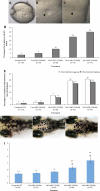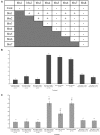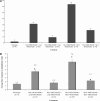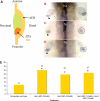Genetic interaction between Bardet-Biedl syndrome genes and implications for limb patterning - PubMed (original) (raw)
. 2008 Jul 1;17(13):1956-67.
doi: 10.1093/hmg/ddn093. Epub 2008 Apr 1.
Affiliations
- PMID: 18381349
- PMCID: PMC2900902
- DOI: 10.1093/hmg/ddn093
Genetic interaction between Bardet-Biedl syndrome genes and implications for limb patterning
Marwan K Tayeh et al. Hum Mol Genet. 2008.
Abstract
Bardet-Biedl syndrome (BBS) is a pleiotropic, genetically heterogeneous disorder characterized by obesity, retinopathy, polydactyly, cognitive impairment, renal and cardiac anomalies, as well as hypertension and diabetes. Multiple genes are known to independently cause BBS. These genes do not appear to code for the same functional category of proteins; yet, mutation of each results in a similar phenotype. Gene knockdown of different BBS genes in zebrafish shows strikingly overlapping phenotypes including defective melanosome transport and disruption of the ciliated Kupffer's vesicle. Here, we demonstrate that individual knockdown of bbs1 and bbs3 results in the same prototypical phenotypes as reported previously for other BBS genes. We utilize the zebrafish system to comprehensively determine whether simultaneous pair-wise knockdown of BBS genes reveals genetic interactions between BBS genes. Using this approach, we demonstrate eight genetic interactions between a subset of BBS genes. The synergistic relationships between distinct combinations are not due to functional redundancy but indicate specific interactions within a multi-subunit BBS complex. In addition, we utilize the zebrafish model system to investigate limb development. Human polydactyly is a cardinal feature of BBS not reproduced in BBS-mouse models. We evaluated zebrafish fin bud patterning and observed altered Sonic hedgehog (shh) expression and subsequent changes to fin skeletal elements. The SHH fin bud phenotype was also used to confirm specific genetic interactions between BBS genes. This study reveals an in vivo requirement for BBS function in limb bud patterning. Our results provide important new insights into the mechanism and biological significance of BBS.
Figures
Figure 1.
bbs3 knockdown phenotypes in zebrafish. (A–C) Photographs of live zebrafish embryos at the 10–13 somite stage. (A) KV (dashed box) is a ciliated vesicle located in the tail bud region in a wild-type embryo. (B) Higher magnification of control KV (arrowhead). (C) bbs3 MO-injected embryo with reduced KV (arrowhead). Magnification: (A) 5×; (B and C) 10×. (D) The percentage of zebrafish KV defects (reduced or absent) generated in MO and control sets. (E) Percentage of heart laterality defects observed in bbs3 morphants and controls. (F–H) Epinephrine-induced melanosome retrograde transport, dorsal anterior view of 5-day-old larvae. (F) Wild-type larvae prior to epinephrine treatment and (G) at the endpoint of 1.5 min after epinephrine treatment. (H) bbs3 morphant larvae showing a delayed response after 3.0 min of epinephrine treatment. (I) Graphical representation of epinephrine-induced melanosome retrograde transport times demonstrating a dose-dependent delay in bbs3 knockdown when compared with wild-type and control-injected embryos. Treatment and sample size noted on the _x_-axis and percentage noted at the top of the bar. *P < 0.001.
Figure 2.
Genetic interaction between eight BBS genes (bbs1_–_bbs8). (A) Twenty-eight subphenotypic pair-wise combinations of BBS MO demonstrated only eight synergistic interactions, noted as ‘+’ sign. Genetic interactions result in (B) KV disruption and (C) epinephrine-induced melanosome retrograde transport delay when compared with control and low-dose BBS MO-injected embryos. Specific RNA can rescue KV disruption and melanosome retrograde transport delay. Control MOs were added when necessary to maintain uniform final concentration of MO in the injection mix. *P < 0.001; Cont, control.
Figure 3.
Medium-dose knockdown of genetically interacting BBS genes results in an increased severity and penetrance of BBS knockdown phenotypes, including (A) KV disruption and (B) epinephrine-induced melanosome retrograde transport when compared with wild-type, control injected and embryos injected with MO combinations of bbs genes that do not genetically interact. Treatment and numbers of embryos noted on the x axis and values on the top of the bars. *P < 0.001; Cont, control.
Figure 4.
Zone of polarizing activity (ZPA) of the pectoral fin bud and Sonic hedgehog (SHH). (A) Schematic representation of zebrafish fin bud prior to 48 h.p.f. ZPA is localized posteriorly and can be labeled with shh expression. Whole-mount in situ hybridization using shh as a probe in the pectoral fin bud of 42 h.p.f. (B) wild-type, (C) bbs7 morphant and (D) low-dose bbs1 MO with bbs7 MO combination. Arrowhead denotes shh expression in the limb bud on one side, and the area of expression is outlined on the other side. (E) Graphical representation of the measured area (µm2) of shh expression domain in the pectoral fin bud of BBS morphants and wild-type. *P < 0.001.
Figure 5.
Zebrafish pectoral fin cartilage staining. (A) Schematic representation of the fin structures: Cl as a dorsoventral line (arrow); Sc distal to Cl and proximal to fin. (B–D) Alcian Blue staining of the pectoral fin shows prototypical cartilage structure in 6-day-old (B) wild-type larvae, whereas (C) bbs7 morphant larvae and (D) low-dose combination of bbs1 MO with bbs7 MO show enlarged Sc structure with two to three cell lines at the proximal posterior region of Sc (arrowhead).
Similar articles
- Bardet-Biedl syndrome genes are important in retrograde intracellular trafficking and Kupffer's vesicle cilia function.
Yen HJ, Tayeh MK, Mullins RF, Stone EM, Sheffield VC, Slusarski DC. Yen HJ, et al. Hum Mol Genet. 2006 Mar 1;15(5):667-77. doi: 10.1093/hmg/ddi468. Epub 2006 Jan 6. Hum Mol Genet. 2006. PMID: 16399798 - Identification and functional analysis of the vision-specific BBS3 (ARL6) long isoform.
Pretorius PR, Baye LM, Nishimura DY, Searby CC, Bugge K, Yang B, Mullins RF, Stone EM, Sheffield VC, Slusarski DC. Pretorius PR, et al. PLoS Genet. 2010 Mar 19;6(3):e1000884. doi: 10.1371/journal.pgen.1000884. PLoS Genet. 2010. PMID: 20333246 Free PMC article. - Mutations in C8ORF37 cause Bardet Biedl syndrome (BBS21).
Heon E, Kim G, Qin S, Garrison JE, Tavares E, Vincent A, Nuangchamnong N, Scott CA, Slusarski DC, Sheffield VC. Heon E, et al. Hum Mol Genet. 2016 Jun 1;25(11):2283-2294. doi: 10.1093/hmg/ddw096. Epub 2016 Mar 22. Hum Mol Genet. 2016. PMID: 27008867 Free PMC article. - [Current status and implication of research on Bardet-Biedl syndrome].
Shen T, Yan XM, Xiao CJ. Shen T, et al. Zhonghua Yi Xue Yi Chuan Xue Za Zhi. 2013 Oct;30(5):570-3. doi: 10.3760/cma.j.issn.1003-9406.2013.05.013. Zhonghua Yi Xue Yi Chuan Xue Za Zhi. 2013. PMID: 24078572 Review. Chinese. - Use of isolated populations in the study of a human obesity syndrome, the Bardet-Biedl syndrome.
Sheffield VC. Sheffield VC. Pediatr Res. 2004 Jun;55(6):908-11. doi: 10.1203/01.pdr.0000127013.14444.9c. Pediatr Res. 2004. PMID: 15155861 Review.
Cited by
- Primary cilia in hard tissue development and diseases.
Li S, Zhang H, Sun Y. Li S, et al. Front Med. 2021 Oct;15(5):657-678. doi: 10.1007/s11684-021-0829-6. Epub 2021 Sep 13. Front Med. 2021. PMID: 34515939 Review. - End stage renal disease, differential diagnosis, a rare genetic disorder: bardet-biedl syndrome: case report and review.
Sowjanya B, Sreenivasulu U, Naidu JN, Sivaranjani N. Sowjanya B, et al. Indian J Clin Biochem. 2011 Apr;26(2):214-6. doi: 10.1007/s12291-011-0116-4. Epub 2011 Feb 4. Indian J Clin Biochem. 2011. PMID: 22468053 Free PMC article. - Functional characterization of Prickle2 and BBS7 identify overlapping phenotypes yet distinct mechanisms.
Mei X, Westfall TA, Zhang Q, Sheffield VC, Bassuk AG, Slusarski DC. Mei X, et al. Dev Biol. 2014 Aug 15;392(2):245-55. doi: 10.1016/j.ydbio.2014.05.020. Epub 2014 Jun 2. Dev Biol. 2014. PMID: 24938409 Free PMC article. - Small organelle, big responsibility: the role of centrosomes in development and disease.
Chavali PL, Pütz M, Gergely F. Chavali PL, et al. Philos Trans R Soc Lond B Biol Sci. 2014 Sep 5;369(1650):20130468. doi: 10.1098/rstb.2013.0468. Philos Trans R Soc Lond B Biol Sci. 2014. PMID: 25047622 Free PMC article. Review. - Physiological mechanisms and therapeutic potential of bone mechanosensing.
Xiao Z, Quarles LD. Xiao Z, et al. Rev Endocr Metab Disord. 2015 Jun;16(2):115-29. doi: 10.1007/s11154-015-9313-4. Rev Endocr Metab Disord. 2015. PMID: 26038304 Free PMC article. Review.
References
- Green J.S., Parfrey P.S., Harnett J.D., Farid N.R., Cramer B.C., Johnson G., Heath O., McManamon P.J., O'Leary E., Pryse-Phillips W. The cardinal manifestations of Bardet-Biedl syndrome, a form of Laurence–Moon–Biedl syndrome. N Engl. J. Med. 1989;321:1002–1009. - PubMed
- Harnett J.D., Green J.S., Cramer B.C., Johnson G., Chafe L., McManamon P., Farid N.R., Pryse-Phillips W., Parfrey P.S. The spectrum of renal disease in Laurence–Moon–Biedl syndrome. N. Engl. J. Med. 1988;319:615–618. - PubMed
- Elbedour K., Zucker N., Zalzstein E., Barki Y., Carmi R. Cardiac abnormalities in the Bardet-Biedl syndrome: echocardiographic studies of 22 patients. Am. J. Med. Genet. 1994;52:164–169. - PubMed
- Slavotinek A.M., Stone E.M., Mykytyn K., Heckenlively J.R., Green J.S., Heon E., Musarella M.A., Parfrey P.S., Sheffield V.C., Biesecker L.G. Mutations in MKKS cause Bardet-Biedl syndrome. Nat. Genet. 2000;26:15–16. - PubMed
- Mykytyn K., Braun T., Carmi R., Haider N.B., Searby C.C., Shastri M., Beck G., Wright A.F., Iannaccone A., Elbedour K., et al. Identification of the gene that, when mutated, causes the human obesity syndrome BBS4. Nat. Genet. 2001;28:188–191. - PubMed
Publication types
MeSH terms
Substances
LinkOut - more resources
Full Text Sources
Molecular Biology Databases




